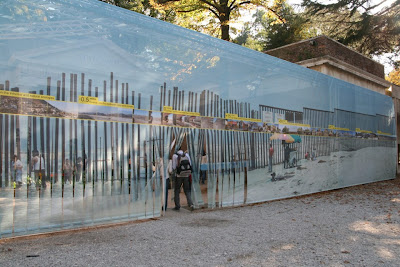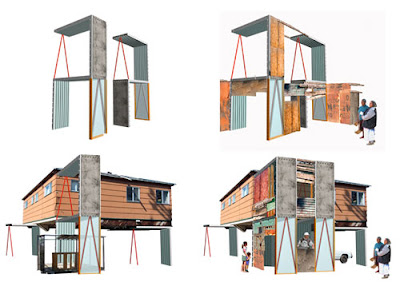 |
| http://www.spatialagency.net/2010/07/28/teddycruzphotolisbetharboe-960×640.jpg |
I attended the Teddy Cruz lecture last night at PSU and it was not your typical architecture discussion. Well it was long and about half way through I was getting antsy, but it spoke about the design of something much different than architecture.
Mr. Cruz first spoke of the tensions and flows of both people and materials between his home of San Diego and Mexican boarder town Tiajana. He used his 2008 Biennale installation as a way of illustrating this dialogue. The installation is a cross-section starting and ending at both towns and looks at how the terrain, fabric and culture changes as you move from one to the other. The most shocking for me were the Long Steel piles that are at the boarder. I had no idea that they extended out into the water as they do. I was also unaware of all the shanty towns and slums that exist in Tiajana that are constructed of San Diego’s trash (garage doors, tires, etc.) and seeing the track homes built on stills was an incredible site. Its ironic that the people living in these slums aspire to have the McMansions of their neighbors to the north. In a sad way they think that large homes will bring them happiness, yet in the meantime if they could build them they would become this foreign object sticking out like a sore thumb in their culture.
 |
| http://www.projetosurbanos.com.br/arquivos/teddycruz01.jpg |
Cruz’s solution although not the most aesthetically beautiful, is a very inspiring solution. He sought out ways for the time being to make their lives a little bit better and structured with a very architectural solution. The use of simple inexpensive trusses help create a frame work that makes the construction of these slums safer and more generative. He realizes this isn’t a permanent solution, but offers it as a means to cope in the mean time. If I had not seen the rest of the lecture I would have though very well that this isnt a good solution, but for Mr. Cruz I feel like it is a solution to buy him some time while he works at the political side of the problem.
The interesting thing about this lecture was that its focus was not primarily on the design of architecture. He is clearly an architect who is interested in redesigning the way we get things done. He is out there talking with developers, the government, the people, and looking for solutions that work for those truly in a need.
This lecture made me start to think, their will always be an architect to design banks, schools, offices towers, pavillions, museums, etc… but what architects will be left to design for the disregarded parts of the world. Should I be using my gift of design to build structures for clients who have access to a vast number of architects, or should I be using my gift to help those who can not afford design services? This is a tricky dilemma because like them I still want to be able to live comfortably and have a roof over my head. Maybe the answer will become more clear as I make the transition from student to professional. Hopefully it wont be too late.

In response to your concern about which population (the affluent or the invisible) to design for, there is also the option of doing both. There are many great organizations to do pro bono work through, such as Architects Without Borders and Architecture for Humanity (both of which have branches in Portland and are inviting to students). Additionally, you could choose to work for (or start) a firm that engages in Public Architecture’s 1% project or other pro bono work as part of its practice.
I appreciate your insight that Teddy Cruz is renegotiating the process for creating shelter. By operating in the larger context of politcal and social activism, he makes room for bringing his design visions to fruition. The truss frameworks are a method for empowering slum dwellers, the larger infrastructures create space for community.
Teddy Cruz’s work back in 1993, dwells at the border between San Diego and Tijuana inspired a practice and practice and pedagogy that emerges out of the particularities of this bicultural territory and the integration of theoretical research and design production.
James at Online College